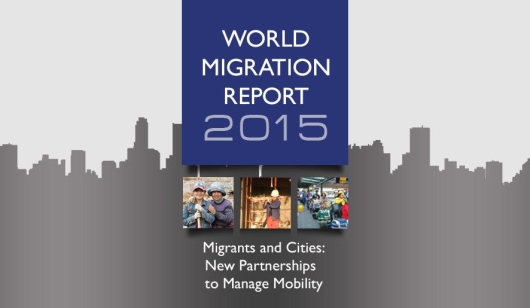Tento článok je publikovaný len v anglickom jazyku.
Geneva – On 27 October 2015, IOM launched its flagship World Migration Report 2015 – Migrants and Cities: New Partnerships to Manage Mobility. The report, the eighth in IOM’s World Migration Report series, focuses on how migration and migrants are shaping cities and how the life of migrants is shaped by cities, their people, organizations and rules.
Speaking at the launch, Dr. June Lee, the report’s editor-in-chief, noted that while much of the current international discussion about migration trends and policy is at national level, this report takes the migration debate to the city level.
“The report focuses on how migration is shaping cities and how the situation of migrants in cities – how they live, work and shape their habitat – helps to reveal the close connection between human mobility and urban development,” she said.
The report reveals that nearly one in five of all migrants live in the world’s 20 largest cities and in many of these cities migrants represent over a third or more of the population.
According to the report, over 54 per cent of people across the globe were living in urban areas in 2014. The current urban population of 3.9 billion is expected to grow to some 6.4 billion by 2050. Migration is driving much of the increase in urbanization, making cities much more diverse places in which to live.
Addressing the notion that existing discussions on migrants and cities tend to focus primarily on the Global North and the integration of international migrants, Lee told the conference that the report takes a global perspective, with particular attention to the situation of migrants in the cities of the Global South. As a result, and for the first time in the WMR series, the 2015 report examines both internal and international migration.
A key finding of the report is that human mobility is growing and will continue to be overwhelmingly urban. “At the same time, the geography of migration flows is changing in line with changes in the global economy. For example, migrants are increasingly attracted to the cities in the countries experiencing higher economic growth in East Asia, Brazil, southern Africa and western India,” said Lee.
Increasingly, the cities of developing countries have become places of both immigration and emigration, given the growing South-South migration – population movements among low- and middle-income countries, the report shows.
Another key finding emerging from the report is that rising migration to cities brings both risks and opportunities for the migrants, communities and governments concerned. “Super-diversity brings challenges, such as residential segregation when certain ethnicities, nationalities or a socioeconomic status concentrate in particular neighborhoods of a city or metropolitan area. Although there are some positive effects of ethnic clustering, policy makers try to combat residential segregation becoming generational,” said Lee.
The report points out that multi-ethnic make-up is the normal condition of many cities in the less developed world and such cities often face mixed migration flows, with a particularly high concentration of internally displaced people and migrants stranded in transit.
Noting the reality that many cities are insufficiently resourced and motivated to become truly inclusive, the report calls for a platform for migration and urbanization to discuss how to balance knowledge, capacities and commitments towards good policymaking and practice for inclusive urban governance across countries.
“We need to consider what roles international communities and organizations play, while bearing in mind that the good practices of more advanced countries might not be globally applicable,” said Lee.
The Report can be downloaded here in English, French and Spanish:
For more information, please contact June Lee at IOM HQ, Tel: +41 22 717 9258, Email: Táto e-mailová adresa je chránená pred spamovacími robotmi. Na jej zobrazenie potrebujete mať nainštalovaný JavaScript.
 Slovenčina
Slovenčina  English
English 